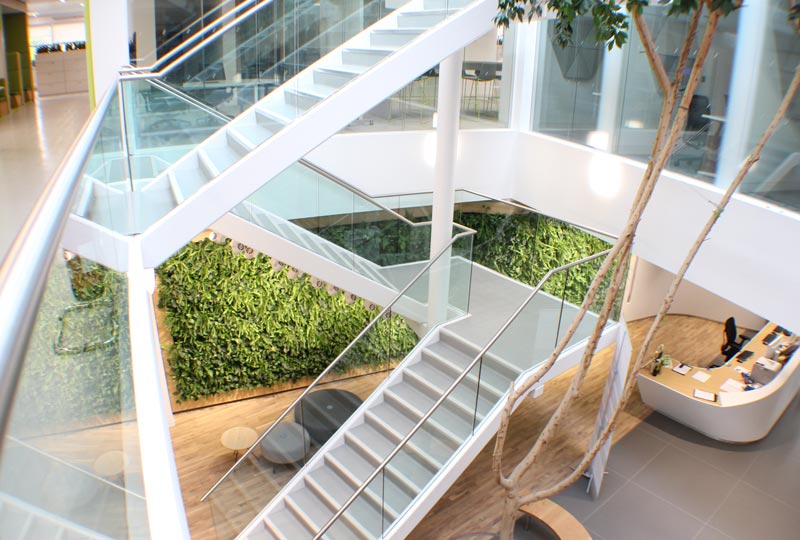What is Biophilic Design?

 Read time: 8mins
Read time: 8mins- Share
- Biophilic design features natural light, fresh air, greenery and natural forms
- It’s becoming increasingly popular and prominent in the working environment
- Thought to improve the health and wellbeing of building’s occupants
- Facebook, Apple and Amazon all incorporate Biophillic Design into their offices
The term Biophilia was first coined in the 60’s to explain mankind’s innate love of the natural world. It pretty much it got stuck behind a clock on the mantelpiece, until the 80’s when Edward O. Wilson used it as the title of his book. From then on, the phrase has bounced around until recently it met the word design and “became the new black”.
Yeah, but what is it?
In a simple sense, biophilic design is a way of creating buildings which in some way encompass a love of nature. We joined the dots, we need nature around us and when we don’t have that, we suffer both in a mental and physical sense.
What makes a design biophilic?
A biophilic design honours nature. It may make use of natural light to fill its spaces, or encompass natural materials like wood and bamboo in its structure.
A good biophilic design can blend into its surroundings and appear as part of the landscape, or it can use nature to accentuate its own structure. It’s also important to consider wellness as part of a biophilic design. Good spaces have views onto nature, areas dedicated to respite and capable ventilation.
Why is it important?
Studies have shown there are direct links between where we live and work and our mental and physical health. When we live and work everyday in toxic environments with poor natural light, no windows and little or no connection to the outside world or nature, we do not fare well.
We’ve long known that offices and urban living are contributors to mental health problems like depression and can exacerbate conditions like ADHD. This phenomenon is also linked to the rise in heart disease and other physical conditions.
How can a building’s design improve our health?
Biophilic design aims to address this imbalance we have in our lives. Our yearning for the natural world, yet being stuck in our brick and mortar prisons. Architects are now using the natural world as inspiration to create beautiful yet functional buildings and structures designed to meld into the landscape, or to bring a glimpse of nature into the urban world.
Biophilic design conjures an emotional connection to nature. As you walk through a structure, you may find evidence of roots or a tribute to a nervous system. These deliberate attempts to return us to nature lift our spirits and it’s been proven that the areas we occupy have a direct influence on our mental state.
Those of use who work in cramped office spaces tend to feel isolated and oppressed, while anyone who is fortunate to live or work in the countryside will be able to tell you what difference the open air makes.
OK, so what isn’t biophilic design?
We musty be clear, there is no correct answer. No one owns the term or the movement, but we can play it safe and use common sense as our guide. A building can therefore be described as biophilic if, in part at least, it aims to improve our relationship with nature. It’s not enough to simply plant a few roses outside it and hail it as a biophilic masterpiece. In the same way, a biophilic design will have nature at its core and while planting a nice tree in a courtyard may brighten up the place, it’s very much missing the biophilic point.
Biophilic designs revolve around the natural. To make the most of the title, a biophilic structure should use natural light, natural materials, imagery, plants, water and can even mimic nature itself in its design.
There will of course be variations to test the rules, but if you look at a building and you feel that somehow, in some way, it makes you feel part of nature, then it probably has an element of biophilic design. Conversely, if you don’t get a connection then it probably isn’t.
Who uses biophilic designs?
As mentioned above, biophilic design can have a dramatic effect on our working life and therefore it will come as no surprise that the big innovators in the field of biophilic design are firms that need to keep their creatives happy.
Facebook, Apple and Amazon are all investing heavily in biophilic design and although some are still in the concept stage, their wild designs look like they’ve come from a utopian science fiction tale. Apple’s flagship new HQ, Apple Park, Cupertino is a biophilic masterpiece and a clear indication of where the smart money is investing its resources.
See drone footage of Apple’s new HQ during construction.
It’s not only tech giants that are looking into biophilic design.
Such is the strength of the link between well being and biophilic design, health care organisations are investing in it too. In the states, where all healthcare is private, studies show that patients will pay more for rooms with views of nature. This is of course a simplistic version of biophilic design, but added to the proven and the perceived benefits, it’s no wonder that new hospitals and health centres are being built with biophilic design at their heart.
Where next for biophilic design?
There’s no sign of it slowing, indeed if anything the movement is gaining momentum. As more and more studies prove the connection between biophilic design and our well being, more and more companies will pick up the banner.
Technology wise, as we move full tilt into the era of the ‘Internet of Things’, it’s possible we will see the birth of smart biophilic buildings. Buildings which will be able to monitor their habitats and change the temperature, humidity and even the speed at which water flows through its water features to suit the moods of its workers.
We’ll also see a good deal of retro-fitted biophilic design, as interior designers and home stores get in on the act. Expect to see green walls, water features, wood cladding and vertical gardens popping up along the High Street and in the office.
At Inleaf, we specialise in helping businesses improve their workplace with office plants and living walls.
Next Steps...
Got a project in mind?
We’re here to help.
Fill in the form below and one of our team will get in touch.


